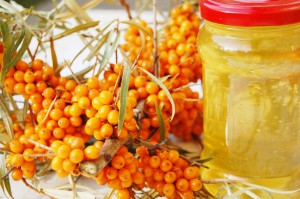I had mentioned to my friend the benefits of sea buckthorn as we were looking for a place to eat.
Always a funny one, my friend responded, “Is that a new sushi dish?”
Not really, I told her.
Actually, sea buckthorn (Hippophae rhamnoides) is a bush with very long roots that keeps soil from eroding and is the richest plant source of omega-7, and it’s fruit is one of the most nutritionally dense foods.
Sea buckthorn contains on average 600 mg of vitamin C, up to 270 IUs of vitamin E, carotenoids (beta carotene, lycopene, zeaxanthine), flavonoids such as quercetin, dietary minerals, and saturated and unsaturated fats. And the oil pressed from the seeds also includes vitamin K.
The fruit is a pretty golden-orange color, and the berry’s juice and oil is used for many health applications. The plant grows in sandy soil up to 14,000 feet and is found in places such as Russia and Canada, but 90 percent is grown in China, where it is utilized for soil and water conservation.
The two constituents extracted from this fruit, flavonoids and oils, are from the fruit pulp and seeds respectively. The proper harvesting and processing yields are tedious and long, plus the berries are collected only once in two years, making sea buckthorn products a bit expensive.
The berries themselves are astringent and oily, and really don’t taste good when consumed raw. Yet leaving the berries out in the frost reduces the astringency and brings out more of its sweetness, and mixing them with another juice such as apple gives them a better taste.
When the berries are pressed, the juice separates into three distinct layers. On the top or first layer is a thick orange cream. The second layer contains the highest content of saturated and unsaturated fats. The last layer is where the juice and other sediments settles to the bottom.
Layers one and two contain the fat sources used for skin products, while the bottom layer is used for edible products. Sea buckthorn can be made into jams, jellies and liquors, with the oils popular in cosmetic and nutritional supplements.
Despite all their goodness and uses, their claim to fame is their high content of a certain type of omega fat. Palmitoleic acid, or omega-7, is a non-essential fatty acid, and the only other rich vegetarian source of this fatty acid besides sea buckthorn is macadamia oil. Though omegas are found in fish and dairy products, sea buckthorn contains a whopping 87 percent unsaturated and 13 percent saturated omega fats in the seed oil, and 67 percent unsaturated and 33 percent saturated omega fats in the pulp oil that also includes omegas 3, 6, and 9.
The omegal-7 fatty acid has anti-inflammatory properties like the others, with studies showing the seed oil helped reduce gastric ulcers. The extract has been shown to help in liver cirrhosis while the oil protects the liver from the damaging effects of toxic chemicals.
Cardiovascular disease is helped by the flavonoids inflammatory actions. Palmitoleic acid is a component of skin, and so sea buckthorn has become a popular buzz word in the skin care industry. It’s added to skin emollients and is also used to make the hair shiny.
Topical applications of this wonder fruit can treat burns, scalds, ulcerations, and infections.
As with most fatty acids, taking them internally has great benefits to the skin as well.
My friend listened patiently to my healthful information and with a playful smile on her face and a wink of the eye, grabbed me by the arm and said, “Come on, let’s find you a nice juicy cheeseburger. You need it.”
My vegetarian eyes rolled in their socket, but I know by tomorrow my friend will have purchased one or two items of sea buckthorn, in the name of sushi, of course.
Gina can be reached at Ima_gina_tion@yahoo.com.






Before read your post I knew about apple, banana, mango and another fruits benefits but I have no idea about sea buckthorn. I think it’s really great for our health and we will definitely apply it our daily life, thanks for sharing it.